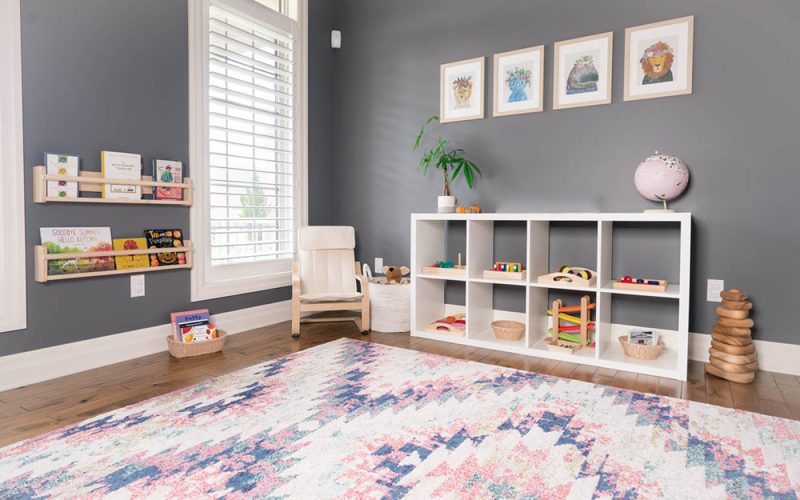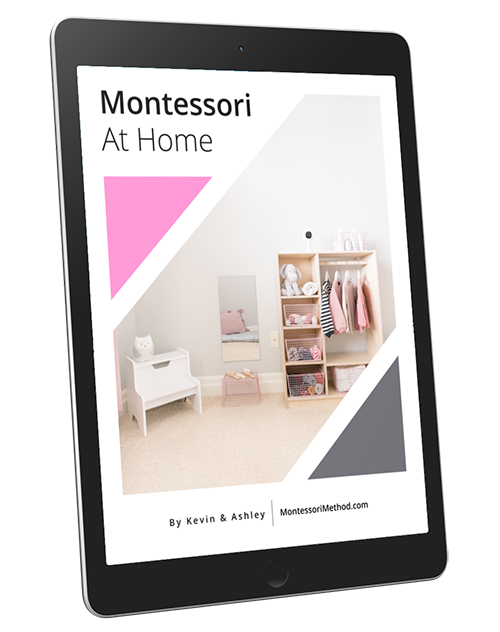In this article, you are going to learn all about incorporating Montessori at home.
Here are the different sections you can quickly jump to:
- What Is The Montessori Method?
- Introducing Montessori Activities At Home
- Montessori Kitchen
- Montessori Practical Life At Home
- Montessori Playroom & Toys
- Montessori Bedroom
- Montessori Outdoors
Free Montessori At Home Guide
If you’d rather read this article in a beautifully designed guide you can download it for FREE here (or tap on the image below)…
Let’s get into how Montessori can be used at home…
When I first learned about Montessori, I thought it was just an education system.
I didn’t realize that Montessori, while deigned by Maria Montessori for schooling, was actually more so an entire approach to raising a child that you can incorporate at home.
And I feel a lot of parents think the same way I used to…
They pass over Montessori as a type of school system and then don’t look into it further if they aren’t interested in the schooling.
I want to help debunk the myth that Montessori is “just an expensive schooling system,” and talk about how families can incorporate Montessori practices into their home.
What Is The Montessori Method?
To understand how you can use Montessori at home, it’s best if you know what the Montessori Method is all about.
The Montessori Method is a way to provide the child with a path to become independent and capable.
That line sums it up perfectly.
Young children want us to “help them help themselves”, and the Montessori approach is observing the child and allowing them the freedom and independence to do the things they want on their own to allow them to grow independent and capable.
How Does The Montessori Method Apply To At Home?
Now that we understand that the Montessori approach is all about helping the child become independent and capable, how can we apply that to our home?
The best way to incorporate Montessori at home is to allow the child to become a contributing part of the family.
Toddlers and children love contributing to the family, and if you think about it, that makes perfect sense.
They grow up watching us do things like getting ready for the day, cleaning, and cooking. And in their little minds, those are exciting things we are doing daily (although we might not realize that).
With the Montessori method, we can promote independence by allowing our little ones to self-care for themselves, help around the house with cooking and cleaning, and just be apart of the family as much as we can.
Young Children Thrive With Montessori At Home
When I first thought of raising a little one, I thought of doing and preparing everything for them.
“They are so small and new to the world. They won’t know how to do much for themselves.” I thought to myself.
Little did I realize that even babies pick up on things very fast, and can contribute at a very young age.
One of my first introductions to Montessori was through an Instagram account that featured a toddler of Montessori parenting, and I remember thinking to myself, “she’s like a mini adult.”
Now, our 17-month-old daughter is very similar in the way that she does many things around the house.
She is doing tasks I wouldn’t have thought a toddler under 2-years-old would be capable to do, such as helping prepare meals, cleaning up, and even some self-care.
Her face lights up, and you can tell she is most happy and proud when she does simple tasks around the house that she has seen us doing for the first year of her life.
Introducing At Home Montessori Activities
My best tip for introducing Montessori at home is just to slow down!
When we started incorporating the Montessori approach at home, we would often rush things without thinking. And it wouldn’t give our daughter a chance to help with things she may be interested in helping with.
For example, at breakfast time your toddler may be capable of helping prepare the meal but, usually, parents will rush the meal prep to get everyone fed (or just not realize that there might have been a task that your toddler would have loved to help with).
When introducing new activities or tasks to little ones it can be time-consuming as it is brand new to them and it will take time for them to learn it.
If you can just slow down and take the time to teach them (sometimes over and over each day until they get the hang of it) you will be thankful you did once they learn and can contribute and become more independent.
Start with straightforward tasks at a young age, and then continue to build on those tasks.
For example, for meal prepping, we started by allowing our toddler to add her own fruit to her cereal.
Once she mastered transferring the fruit to the bowl, we started allowing her to peel her own banana before adding it to the cereal.
The last step was teaching her to pour her own milk from a small toddler-sized glass pitcher into the bowl.
Now she can do pretty much every step in preparing her own cereal. It keeps her busy while we do other activities in the kitchen to prep for breakfast, and she is thrilled and proud at the same time!
Montessori Kitchen
Let’s take a further look into how you can incorporate Montessori at home within the kitchen.
As mentioned earlier in this article, having your little one help with meal prep is a great activity for kids of all ages. This can include tasks like transferring foods, pouring, mixing, spreading, and slicing.
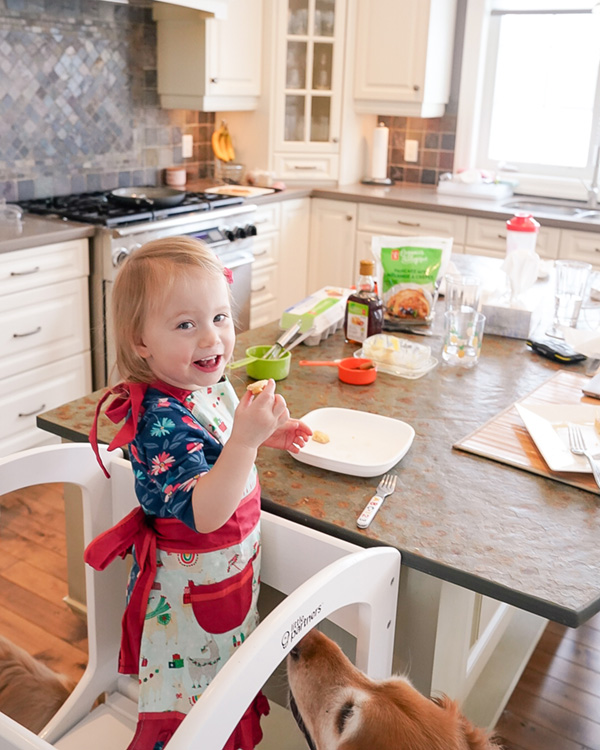
In the picture above you can see our little one (at 21 months) taste-testing pancakes we made together. She helped pour all of the ingredients together, mixed them together with a small whisk, and practiced her spreading with the butter on the finished pancakes.
Other kitchen activities that your little one can help with include washing dishes, setting the table, washing their hands, scrapping off their plate after eating, loading the dishwasher and putting dishes away from the dishwasher.
If you want to incorporate Montessori into your kitchen I recommend a Montessori Learning Tower that allows the child to be at counter height.
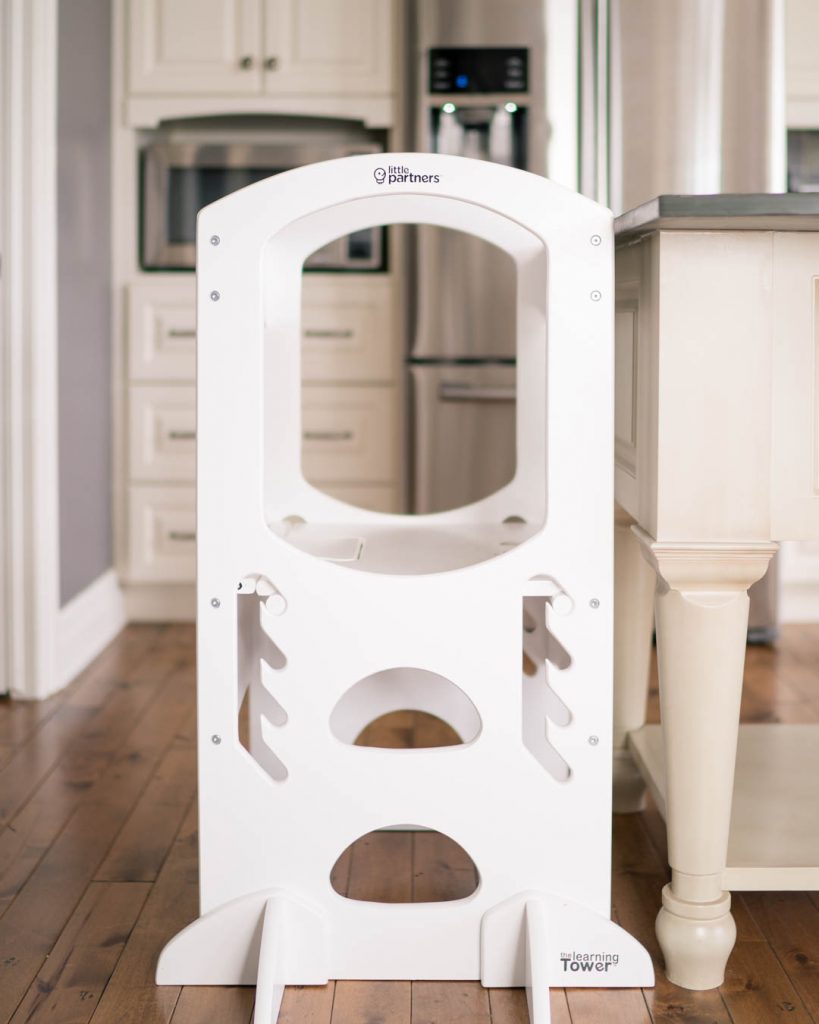
This is one of my highest recommended Montessori inspired purchases, as it allows your little one to help with plenty of tasks in the kitchen in a safe way.
Another excellent kitchen addition is a Toddler Sized Practical Kitchen which you can see in the picture below.

With a water station, this allows them to do practical life tasks like washing their hands and dishes. We also now store all of K’s dishes and cutlery in her toddler kitchen so she can help by getting a plate or bowl, cup, and cutlery for meals.
The toddler kitchen is a nice addition, but it definitely isn’t necessary (especially if you have the learning tower) as they can help with the water activities in the sink and you can set up kitchen drawers for them.
Following the Montessori principles, it’s important to have somewhere in your kitchen or eating area that is accessible for a toddler.
Over the past 6 or 7 months, our kitchen space has evolved and we have 3 different options for K:
1 – Learning Tower – we keep our learning tower at the counter so K can climb up on her own in the morning for breakfast or for snacks
2 – Weaning Table and Chairs – we purchased a beautiful toddler sized table and chair set from Sprout Kids (use code OMJ for 10% OFF) that K can use anytime she likes (we usually give her the option of eating her snacks at the learning tower or weaning table)
3 – Stokke Chair – we’ve always eaten dinner together as a family at our kitchen table and this Stokke Chair now allows K to get up the table and leave the table on her own
Of course, 3 options aren’t necessary for a child but I think it’s important to have at least one area in your kitchen that your little one can access on their own!
Montessori Practical Life At Home
A lot of what’s done in the kitchen can fall into this category as well, but on top of those kitchen practical life activities, kids can help around the house in many other ways.
We have our recycling bins and mini garbage set up for K so that she can help recycle and throw things out. She is also always happy to help us carry the garbage or full recycling bins out to the garage.
We purchased some cheap toddler-sized cleaning tools that allow K to help dust, sweep, and mop the floors. She also enjoys cleaning our glass backdoor with water in a small spray bottle and a cloth.
Another great practical life activity is taking care of flowers or plants in the house by helping arrange them, wiping them down, and watering them.
Simone from the Montessori Notebook has given us some great practical life activity ideas and I recommend checking out her blog for more ideas.
Montessori Self-Care
Young toddlers can and often enjoy caring for themselves by doing activities like brushing their hair or teeth, getting their own tissue to blow their nose, choosing their outfit for the day, and helping to get themselves dressed.
In Montessori homes, it’s common to see Montessori self-care stations set up for children.
These often include items such as a mirror at child height, a comb or brush, tissues in reach, and somewhere to sit and get changed/put on shoes.

The image above is a perfect Montessori self-care station that was submitted by @DestinyandDella. She has a mirror at child height, a bowl with water, and some self-care items such as a toothbrush, brush and some cream.
At 17-months-old K is starting to show more interest in self-care, and we are working on setting up a little Montessori inspired self-care station for her and will be updating this page with our self-care area when it’s ready.
Montessori Playroom & Toys
Another way to incorporate Montessori at home is with a Montessori playroom.
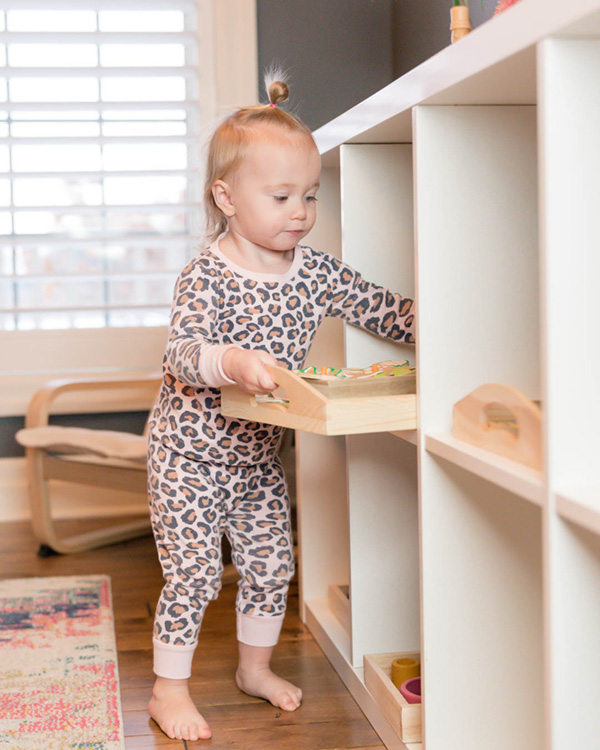
In a Montessori inspired playroom, all activities should be at the child’s height so they can use what they are most interested in. These Montessori toys should also be displayed beautifully on an open shelf to entice the child to engage with them.
It’s recommended to limit the number of activities on display to promote concentration and allow the child to master each activity. We’ve found 8-10 activities to be a good number for our toddler, but we also have additional activities on display in other areas of the house as well.
In a Montessori playroom, each activity serves a purpose. Montessorians generally avoid battery-operated toys that were made more for distracting and keeping children busy rather than helping them learn skills.

You may also notice in the above picture that all of the activities on the shelf are in a basket or wooden tray, which makes it easier for the child to get the activity themselves and put it back when they are finished with it.
We also try and always leave each activity unfinished or undone (ie the puzzle pieces are on the side or the stacker isn’t stacked) which helps promote engagement with the activities.
Rotating your child’s toys weekly is a great way to keep your child engaged with his/her activities. We’ve been rotating toys in the playroom every Monday and have found that having a set day works best so we don’t lose track of how long they’ve been out for.
Observation is important in Montessori. If your child is really enjoying or working on mastering certain activities it’s best to keep that toy on display for another week.
If you’d like to learn more about Montessori playrooms I’ve written a full guide that you can find here.
Montessori Bedroom
Independence in the bedroom is a big part of the Montessori at home approach to parenting.
There are many ways you can make your little one’s bedroom more Montessori friendly (and I go over many of them in our Montessori Toddler Bedroom Tour), but it can start with just making things more accessible for the child.
This can include having a floor bed instead of a crib to allow your child to get in and out of bed on their own, having activities at their height for them to use when they are in their bedroom, a cozy place to read books, and a toddler-sized wardrobe to allow them more independence with getting dressed for the day.
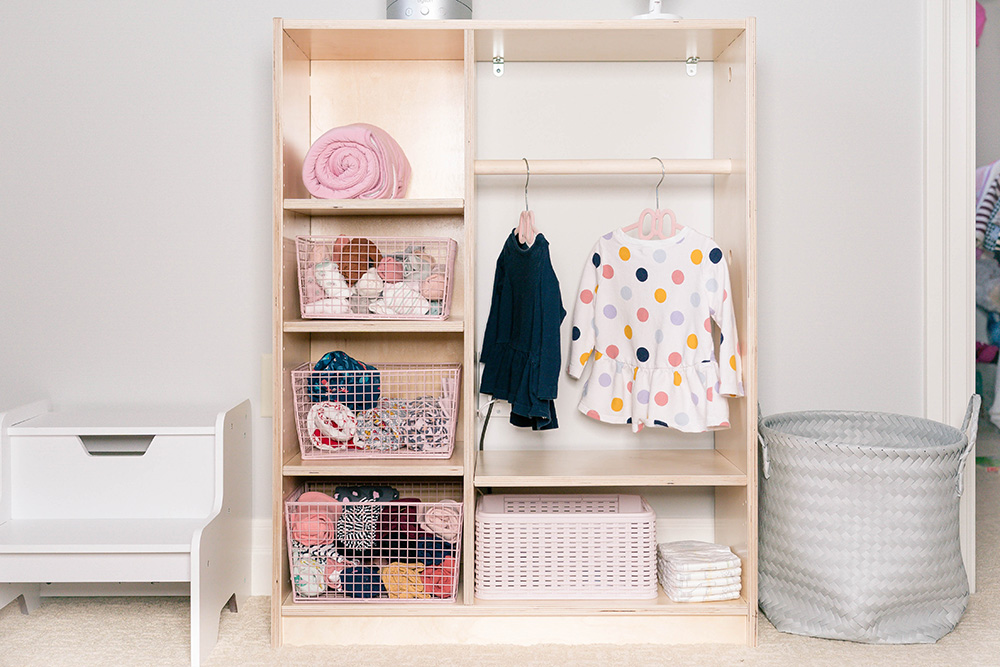
Above you can see a picture of our new Sprout Montessori Wardrobe that allows K to help pick her outfit for the day and eventually get dressed on her own. At her age, we set out two shirts that she can pick from and then help her get dressed for the day.
Another tip that we didn’t think of when originally setting up our daughter’s room, is to have all of the artwork at the child’s level.
Like many parents, we made the mistake of decorating the room to look good to us (at our height), without thinking ahead to when our daughter would start to appreciate the artwork and the decor in her bedroom.
We’ve included a small shelf with 4 activities in K’s bedroom, which allows her to independently play when she wakes up or before she falls asleep.
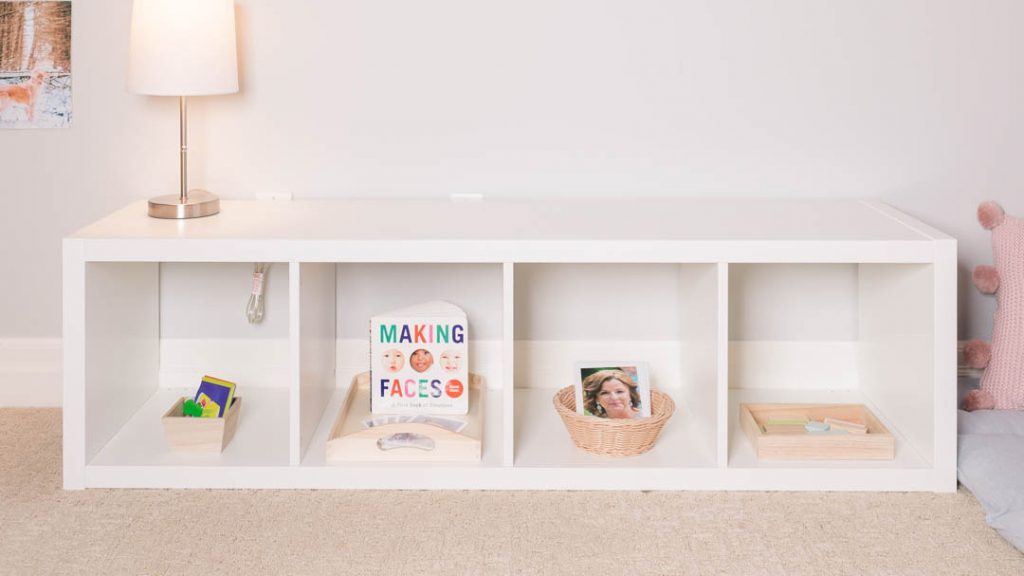
Since the transition to the floor bed (about 1.5 months ago) we haven’t had issues with the activities interfering with her sleep, although she does like to turn on the lamp and look through more books before falling asleep.
We set up a cozy reading nook in her Montessori inspired bedroom that she can use at any time.
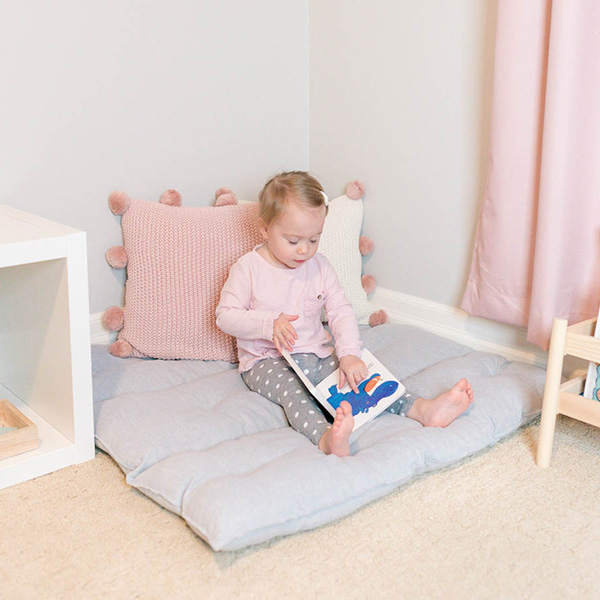
We are often reading to her before nap and bedtime right in her bed, but use this reading nook at other times during the day if we find ourselves upstairs.
“Childproofing” the bedroom is important, as with the Montessori at home approach you are often giving the child a lot of freedom and independence in their bedroom (and sometimes when you are sleeping).
Montessori Outdoors
A big part of Montessori is allowing the child to explore nature and enjoy the beauty of the outdoors. Outdoor play is encouraged at home.

This can be as simple as the exploration of nature in your yard (if you don’t have a yard, you can go to a local park or forest).
It can also include outdoor practical life activities such as raking leaves, watering plants, working on gardens, watering grass, picking weeds, etc.
On top of that, it’s recommended to have activities and toys that were made for outdoor play to allow them to spend more time outside and work on their gross motor skills.
Recap Of Montessori At Home
I hope this article has shed some light on how Montessori can be used at home, even if you aren’t interested or able to enroll your child in a Montessori school.
Montessori is such a beautiful approach to raising a child and, in my opinion, should be incorporated in all homes.
Set up your home to allow your child to help themselves, and they will thrive!
